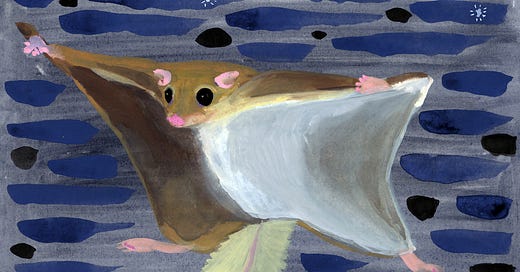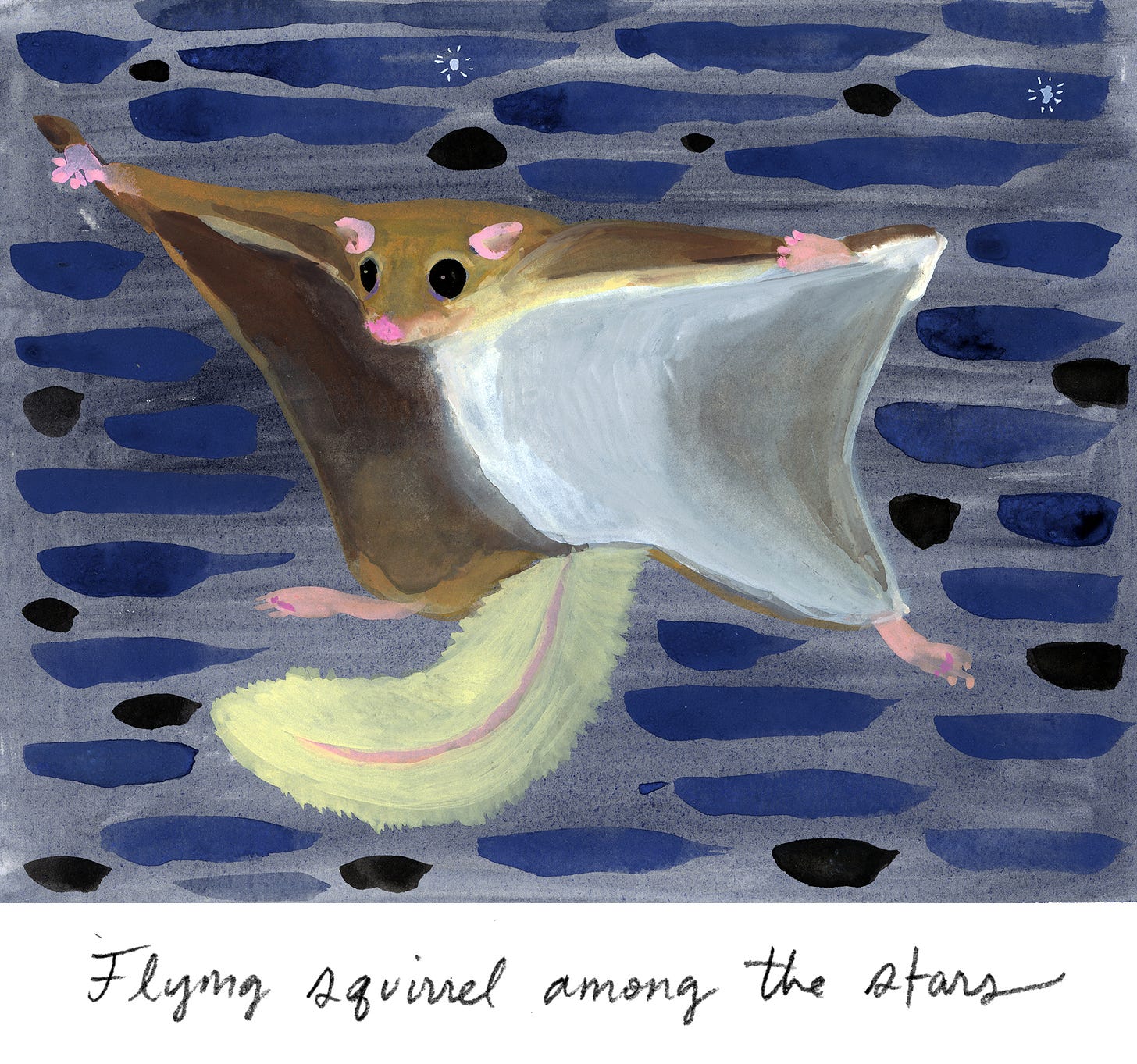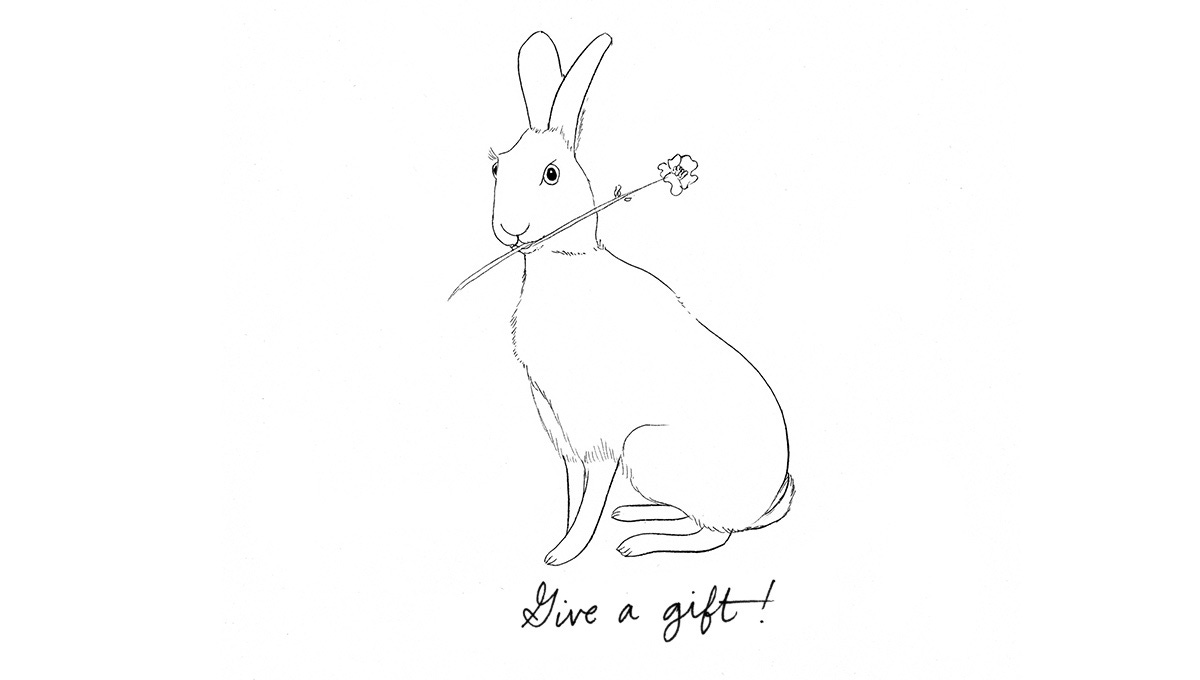Hi, friends — this week the groundhog predicted a long winter and we’re halfway to spring. There’s been a couple of storms, and, as usual, the juncos were the only creatures out and about. I enjoy finding their small, scratchy tracks in the snow. Some animals are bold this way. Others, like the flying squirrel, are a bit of a mystery, everywhere without a trace. — Amy Jean
ps: Heads up, there will be a special Wild Life edition for Valentine’s Day, aka World Bonobo Day <3 Keep an eye out then!
We found a tiny flying squirrel, dead as dust, alongside a box. It must have come in an open door and gotten trapped (I promise there are none in the attic). The little squirrel was palm-of-your-hand-size small—much smaller than expected. I’ve seen many a poor, dead mouse in my day, small birds, too. All these tiny creatures are so delicate and perfect and sad and silent. The flying squirrel’s paws, the size of peanuts, crushed me the most. How often had they held the night air, leaping, gliding from one dark tree to the next?
The southern flying squirrel (Glaucomys volans) is common throughout the eastern United States. They are deep-of-night nocturnal, so it is rare to see them in action. Right now they are keeping warm, nestled together in communal dens of up to twenty individuals. Flying squirrels use natural cavities in trees and woodpecker holes for their nests. When I look at winter trees, their bare branches cutting the sky into mosaics, it is good to remember they are full of warm, furry creatures.
Flying squirrels are really gliding squirrels. They’re shaped like kites with a long flat tail and flappy membranes that extend from paw to paw. When they’re not gliding, these extra membranes are a bit cumbersome, like awkward couture. But they’re incredibly graceful gliders, leaping from tall trees and maneuvering in midair.
A single glide is typically around 30 ft., though they can go further from greater heights. I wonder how young squirrels must feel, the first time they take a flying leap. What subtle forces of gravity versus air pressure must they know? They wriggle their paws and lift flaps of cartilage near their wrists to steer. Their tails keep them stable.
These squirrels are very social and active communicators. If you hear what sounds like nighttime birds, you might be hearing the high-pitched chirps and barks of a flying squirrel’s conversation. They mate in late winter, later this month, and have three to four babies in April. The mother raises the young entirely on her own and, though they develop fast, they tend to stick with a family group as their flying skills develop.
Before we found the little squirrel, I had no idea how common they were in our area. I took another look at its little paws and whiskers and buried it outside under the leaf litter. As with many mammals, flying squirrels take turns being present and absent, leaving behind only the slightest traces and clues. By design, our paths rarely intersect. And, if all goes well, I’ll never see another one again.
Flying squirrel links—
Honestly I could watch this footage of northern flying squirrels in slow motion forever, flinging themselves off trees, swooping, and landing with what looks like enormous blankets. [Nature via YouTube] And more with David Attenborough [BBC Earth]
This is a kind of weird but interesting experiment with flying squirrels, a crane, and a football field. [NatGeo via YouTube]
Flying squirrels squeaking in the night, in Florida. [YouTube] They also communicate with ultrasonic calls and here’s a study in the Journal of Mammalogy.
Animal encounters in recent comments—
Lots of great news of turkey vultures gathering, consuming, being chill—thank you!
Also—
The February issue of Wild Life / Rabbit, Rabbit considered the mysterious three-hare motif. Subscribe or give a gift below for good luck, and to learn more about rabbits.
Wild Life #38 / this newsletter is a place to learn about the life around us, one daring squirrel at a time. I do this because I’m not sure what to do about the millions of species in danger of extinction. It means something to see and enjoy the life around us. Thanks for reading and see you soon.






Oh Amy. This is so beautiful.
Hi! indeed this newsletter is also a blessing foe me.